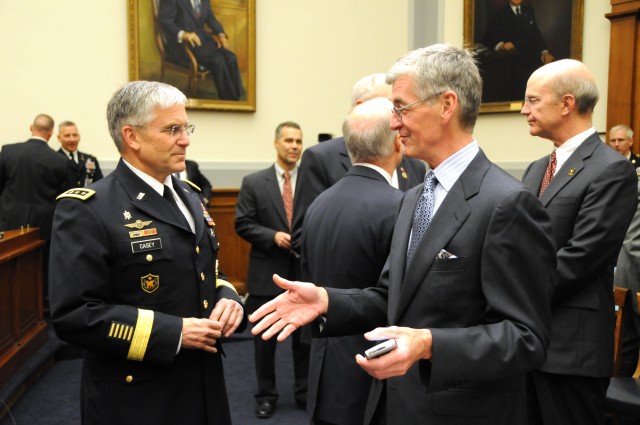WASHINGTON (Army News Service, May 18, 2009) -- Soldiers could find themselves with as much as 24 months time between deployments if plans for military activities in Iraq and Afghanistan come to fruition.
During testimony before the House Armed Service Committee May 14, Chief of Staff of the Army Gen. George W. Casey Jr. told lawmakers Soldiers could see as much as two years dwell time by 2011
"In 2007, based on what I thought the force structure would be over the next four years, I thought we wouldn't get quite to one year out, two years back by 2011," Casey said. "If we execute the president's Iraq drawdown plan, and I have no reason to doubt we will, we will actually do better and actually get to the 1/2 or even better ratio -- we have to do that."
With a two-to-one dwell time to deployment ratio, Soldiers would spend more time at home training and with their families than they would downrange, Casey said. Fixing that ratio is part of correcting a lack of balance in the Army, he said.
"The most important thing we can do to get back in balance is to increase the time our Soldiers spend at home," Casey said. "Dwell time, the time spent at home, is important for several reasons. First, it gives our Soldiers time to recover from combat tours -- and 12 months is not enough." The general also said increased dwell time allows Soldiers to prepare for their next mission, as well as different kinds of missions.
Casey and Secretary of the Army Pete Geren were on Capitol Hill to discuss the Army's Fiscal 2010 budget request with Congress. The manpower portion of that budget reflects the Army's recent success in meeting a directive from the last administration -- increasing the number of Soldiers across the Army. Success with that goal has a direct impact on Soldiers serving now in Iraq, Casey said.
"It allows us to begin coming off stop loss this year," Casey said. For the Army Reserve, units will begin deploying without stop loss in August, he told lawmakers. For the Guard, in September, and for the active-duty Army, in January.
The new budget will not fund development of eight manned ground vehicles that were part of the Army's Future Combat Systems.
"I was not able to convince the Secretary of Defense we had incorporated enough of the lessons learned from current operations we were in, into that MGV," Casey said. As a result, the Army has stopped developing the current MGV and will start over with a new vehicle.
"We expect to come back and have a new concept design after Labor Day," Casey said.
The general said he expects that a new vehicle concept could be proposed, and developed and out to the force in five to seven years -- along the same timeline that it was going to take to get the MGV to Soldiers.
The general said the Army has had great success with fielding the Mine Resistant Ambush Protected vehicle in Iraq and Afghanistan.
"One of the most significant things that's happened over the last year is the infusion of about 10,000 MRAPs into theater," Casey said. "I've talked to Soldiers in Afghanistan -- sometimes they gripe a little about it being hard to drive off the road. But anybody that has been in an MRAP and had an improvised explosive device go off under them and lived -- is a convert."


Social Sharing